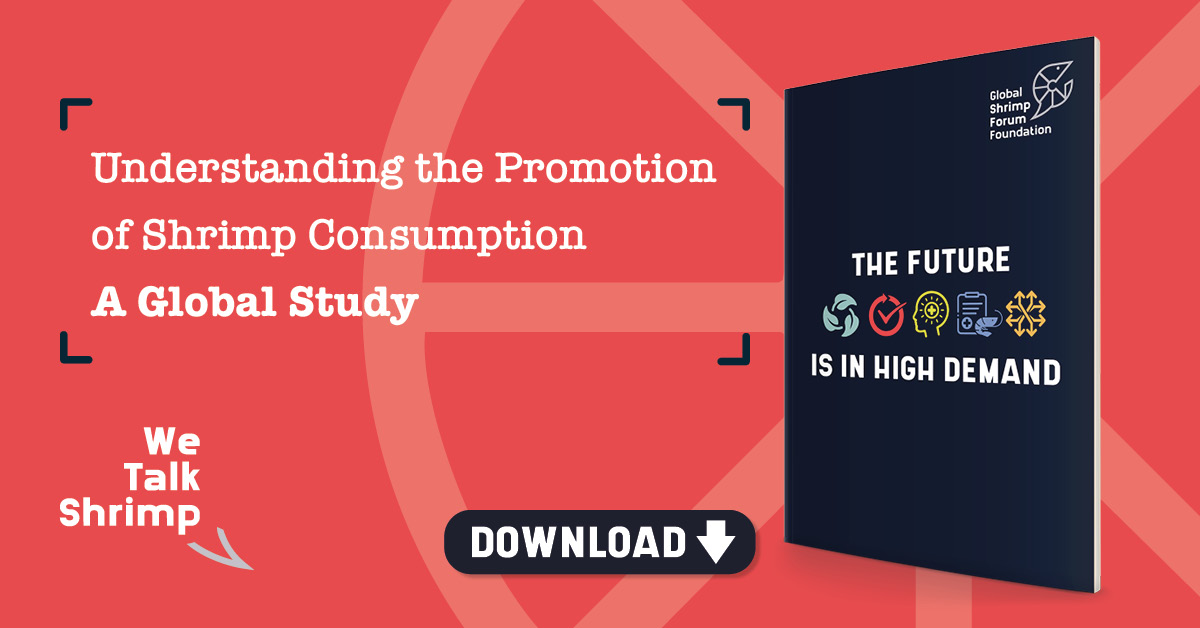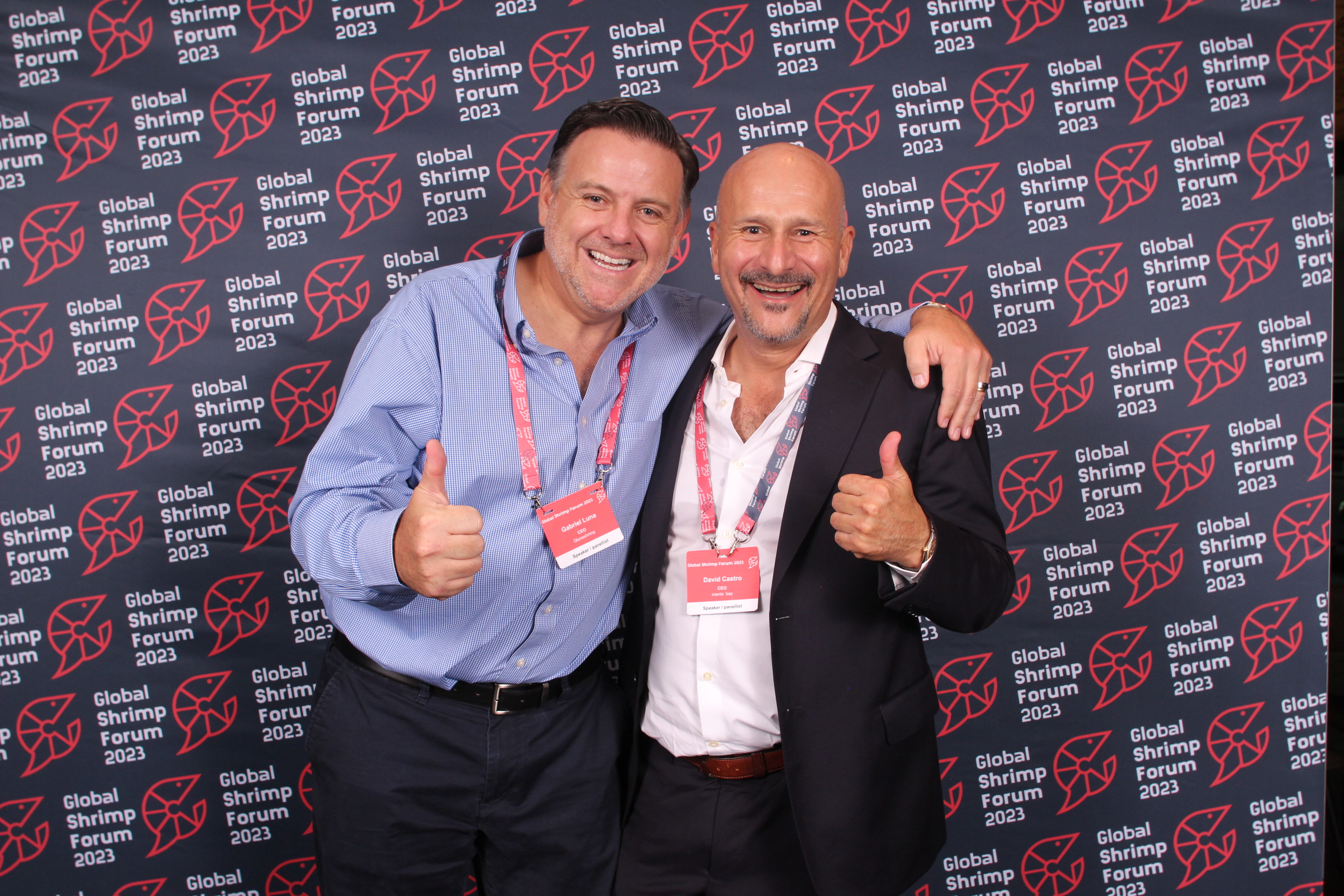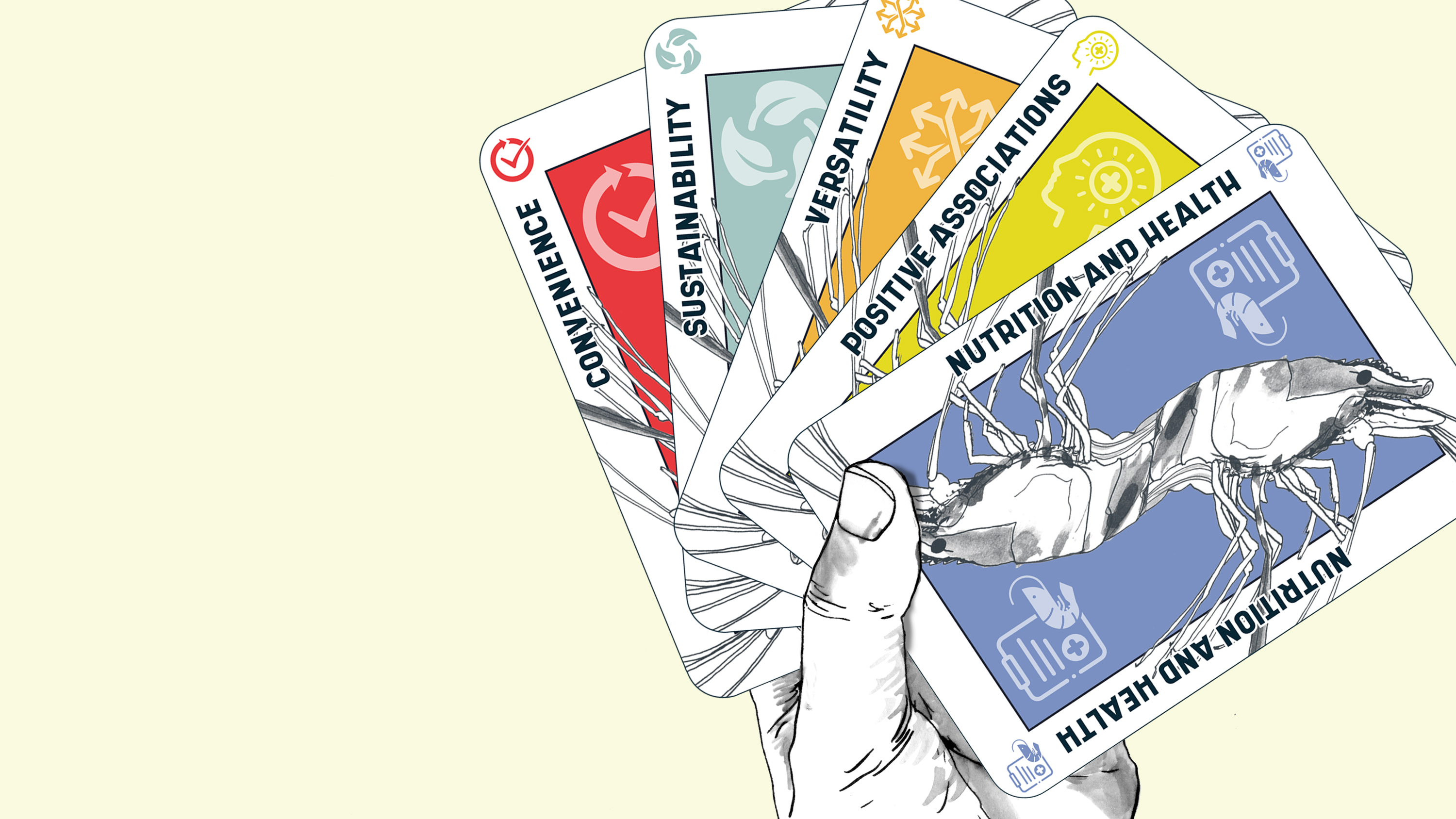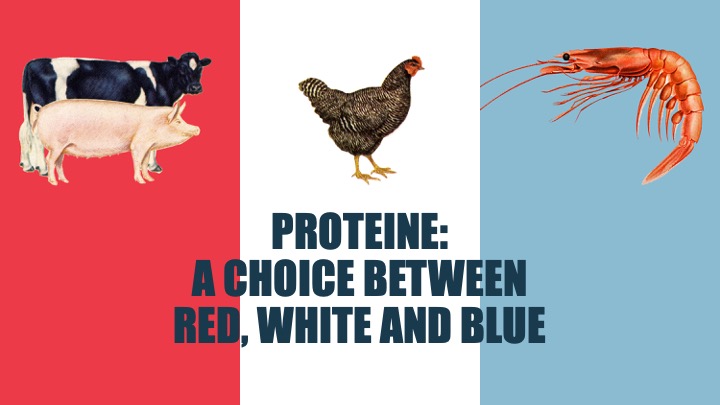Amidst a global oversupply situation and historically low farm gate prices, shrimp farmers worldwide have increasingly been raising their voices in an attempt to get the message across that if shrimp production continues to increase, the industry should collectively focus on promoting sustainable shrimp consumption. Increasing consumption should lead to more stable and higher prices. Promoting shrimp consumption should be possible because shrimp farmers agree that their product is a tasty, healthy, and sustainable protein that can easily compete with other proteins, especially now that shrimp has become more affordable. In contrast, other proteins have become more expensive.

The signals that increasing the consumption of sustainable shrimp should become a focus for the industry led me to propose to my board at the Global Shrimp Forum Foundation (GSFF) that we hire a consultant who could inspire our audience with some initial strategic thinking and recommendations about consumption promotion. Around the same time, the low price levels and subsequent call for efforts to promote shrimp consumption also prompted David Castro of Manta Bay Seafood and Gabriel Luna of Glunashrimp to push the industry to establish the Global Shrimp Council (GSC)—more about both initiatives will follow in this blog.
In 2024, the Shrimp Blog is supported by: Inve Aquaculture, Taprobane Seafoods, DSM-Firmenich, Zeigler Nutrition, Bioiberica, Megasupply, American Penaeid, and Omarsa.

Efforts to Establish the Global Shrimp Council Started Around Two Years Ago
David Castro and Gabriel Luna approached me in early 2023. They told me they were working on an initiative to establish an organization with the mandate to promote shrimp consumption through collective marketing. Frustrated that other initiatives to develop such an organization had never materialized, they seemed incredibly motivated to get this done. Besides their enthusiasm, David’s experience establishing and managing promotion bodies related to Mexican seafood and Gabriel Luna’s position as an informal ambassador of Ecuador’s shrimp industry made me believe that these two guys might be able to overcome challenges where other initiatives failed.

Photo credit: Pierre Banoori Photography
It became clear that David and Gabriel had been working since the end of 2022 on a proposal to the industry to establish the GSC in partnership with the US’s National Fisheries Institute (NFI). The NFI already manages a range of other seafood consumption promotion councils, and is experienced in navigating the US regulatory landscape, and establishing and running seafood consumption promotion bodies. The GSC would be a voluntary, membership-based organization comprising shrimp producers worldwide. The organization would be governed by a board elected by its members, who would decide on the GSC’s strategy. The NFI would provide the GSC with the necessary support to make it credible and reliable.
David and Gabriel needed a platform to talk to producers worldwide. It was already clear to me that the Global Shrimp Forum (GSF) audience was looking for more focus on promoting the consumption of sustainable shrimp. We at GSF were uniquely positioned to support David and Gabriel by hosting a meeting where they could share their proposal with owners of shrimp producers worldwide, including from Ecuador, Honduras, Guatemala, India, Indonesia, Saudi Arabia, and Vietnam, who had all confirmed to attend the GSF in 2023. I was also well-positioned to support David and Gabriel by leveraging my network among the significant shrimp producers in Asia. When presenting this opportunity to support the industry to my board at the GSFF, my fellow board members agreed that it was a no-brainer. From that point, we started to engage and prepare for the meeting in Utrecht.
The executives of around 30 of the world’s largest shrimp producers attended the first GSC meeting in Utrecht. The ask from David and Gabriel to this group was to provide them with financial support to hire Miguel Barcenas, a seasoned consultant with 35 years of marketing experience—including 12 years overseeing the highly successful Avocados From Mexico marketing campaign internationally in support of the Association of Avocado Exporting Producers and Packers of Mexico (APEAM)—to use his experience with Mexican avocados to develop a detailed proposal for the funding mechanism and organizational set-up of the GSC. The companies that agreed to support them would become the GSC’s founding members, and would collectively elect the GSC’s first board in the first quarter of 2024. At the end of the meeting, almost all of the companies present agreed to provide the required support, and David and Gabriel could move ahead.
More to follow later in the blog about where the initiative’s at today. But first, I’m going to share with you a few of the outcomes from the study published by the GSFF in December 2023 on strategizing the promotion of sustainable shrimp consumption.

Inspiring the Industry With Strategic Thinking Around Promoting the Consumption of Sustainable Shrimp
The GSFF is a non-profit organization. If we have a financial surplus after the annual GSF event, we will spend this surplus on projects that benefit the industry. We have formulated three buckets of initiatives:
- Mangrove conservation
- Aquaculture improvement projects
- Research
In the case of a research project, the requirement is that the topic is pre-competitively relevant, and that the results will (i) become public and (ii) be presented at the following year’s GSF event.
Because we realized that promoting the consumption of sustainable shrimp was likely to become the hottest topic of the 2023 event, we decided to hire a strategic marketing consultant. Over six months, Arnd Jan Gulmans, a seasoned marketeer, assessed how we as an industry could strategize around promoting shrimp consumption. He presented the results both at the GSF (see the video below) and in a GSF report published in December 2023. This was the first study financed and issued by GSFF, and I’m sure more studies like this will follow.
Arnd Jan’s findings concentrated on a few topics:
- When promoting shrimp consumption, geographically speaking, where should we start?
- What are the shrimp industry’s unique selling points (USPs) compared to other animal proteins?
- What cards should the industry play, and how should they play them right?
Although I strongly recommend that you download the report (it’s FREE!) and take some time to digest it all, I will summarize some of Arnd Jan Gulmans’ main insights:
The 4 A’s
Arnd Jan suggests using the 4 A’s to decide where to start using promotion as a tool to promote shrimp consumption. The 4 A’s comprise:
- Availability: shrimp is readily available to buy
- Affordability: people can afford to buy shrimp
- Awareness: people are aware of shrimp as a good food choice
- Attraction: people want to buy shrimp.
His main observations are:
- In India and China, affordability and availability are limited to larger cities and coastal regions compared to Western markets. This means that the opportunity to develop shrimp consumption through promotion is also limited. In these markets, the most significant opportunities for promotion efforts are found in bigger cities where affordability and availability don’t represent bottlenecks.
- Affordability and availability will continue to grow in other regions in China and, somewhat more slowly, in India. This means that shrimp consumption will likely grow autonomously over the coming years. As this process unfolds, the bottleneck will shift towards awareness and attraction, and the opportunity for growth through promotion will consequently increase.
- Food habits are not set in stone; they change over time. In fact, they’re shifting meaningfully in the US, Europe, and China. This means that people are reconsidering their choices and are open to suggestions. This represents an opportunity to increase people’s awareness about—and attraction to—shrimp.

A Strong Hand of Cards
During his study, Arnd Jan concluded that the shrimp industry has a strong hand of cards to play with. This hand consists of the following USPs:
- Positive Associations
- Nutrition and Health
- Versability
- Convenience
- Sustainability

- Positive associations: The strong associations people have with shrimp are a good basis on which to build. However, they can’t be the whole story. First of all, while they can provide a strong emotional connection, they don’t offer any rational arguments to eat shrimp. What’s more, they don’t bring anything “new.” This presents little opportunity for storytelling.
- Nutrition and health: This is a powerful card to play as it’s highly relevant worldwide, and this relevance is likely to become greater in the coming years; health consciousness is set to grow, especially in markets with aging populations. On top of that, robust evidence supports shrimp's nutritional values and health benefits. Still, there remains a risk of “incidents” that could harm the health reputation of shrimp (think antibiotics, pollution resulting from (natural) disasters, etc. An important caveat with communication around nutrition and health is that people don’t like to be told what they should or shouldn’t eat: “preaching” doesn’t work. The pitfall is that for some people, “healthy” is considered at odds with indulgence: if something is good for you, it can’t be something you love to eat. This presents an opportunity for the shrimp industry to show that these can go hand in hand. “First seduce, then convince” could be a vital motto here.
- Versatility: The versatility of shrimp as a food option is highly relevant, and the evidence is compelling. As such, versatility opens up a rich vein for storytelling content that inspires and even seduces people to eat shrimp more often. There is, however, a strong competitor in this area, and that’s chicken. This makes it questionable whether versatility by itself would be a strong enough reason to choose shrimp over chicken (competitive strength). The versatility card likely needs to be combined with another one.
- Convenience: Shrimp is a very convenient ingredient in the kitchen, primarily because of the short cooking time and the fact that (peeled) shrimp doesn’t require further preparation. Frozen shrimp presents yet another convenience benefit as it can be used directly in a dish without thawing—what could be more convenient than that? Finally, the possibility of using precisely the desired amount of (frozen) shrimp means less food waste. What’s striking here is that, despite all of the convenience benefits mentioned, shrimp isn’t currently perceived as a convenient food, especially among those who haven’t cooked with it before or use it infrequently. This relative unfamiliarity makes shrimp seem less convenient than it is: any ingredient outside someone’s comfort zone is likely perceived to be challenging to prepare.
- Sustainability: Sustainability will only become more relevant in the coming years. Awareness around climate change will no doubt grow. More importantly, so will awareness of the link between dietary habits and climate change. Shrimp can be a strong alternative for those who become conscious of the climate effects of eating meat, especially red meat, but who don’t necessarily want to become vegetarian or vegan. The problem with sustainability is the large gap between the performance of the “front runners” in sustainable shrimp production and those lagging behind. This gap presents a risk of negative publicity (i.e. there’s a risk that playing this card will backfire). A claim that shrimp is a sustainable or responsible choice in light of climate change, backed up by best-in-class examples, can (and will) invite criticism that points at those lagging producers. Such criticism can easily damage the sustainability reputation of shrimp in general and sidetrack promotional efforts.

Making a Choice
Choosing the strongest card(s) to play, of course, depends on the (market) scope and the objectives of a specific promotional effort. Based on assessing the relative strengths, we can conclude that the “nutrition and health” card combines high relevance, strong evidence, and low risk. The biggest caveat is that we don’t want to preach; the health message should be combined with a more inspirational angle. The “versatility” and “convenience” cards provide just this: an opportunity to add a “fun” element to communication. This will boost people’s curiosity and seduce them into buying shrimp more often. This fun and inspiring element can be even stronger when grounded in the positive associations in consumers’ minds.
Framing the Ambition
It’s important to think carefully about how to frame the ambition for shrimp promotion: if the bar is set too low, our ambition won’t motivate people to join in the effort. Our ambition must generate momentum and motivate different stakeholders to work together. It’s also important to consider the timeframe: the ambition shouldn’t be defined according to too short a term. Setting a time horizon of 10 years is reasonable—it will probably take this amount of time to make a real difference in dietary preferences and behaviors.

We should also think carefully about how we talk about shrimp. If we emphasize that shrimp is a “special” product, we may reinforce the idea that shrimp is only for very specific occasions. The result could be that a portion of our target audience then adopts the idea that “shrimp isn’t for me.” If we start to show how shrimp can actually add something to regular food routines, this will trigger people’s curiosity. In turn, it will invite them to choose shrimp.
Consumers are actively reconsidering their food habits, and (animal) protein is at the heart of the changes. We’ve also seen that shrimp has many attractive properties that can compete with these other proteins. One approach would, therefore, be to frame the ambition in terms of this “protein competition”: as a choice between red, white, and blue. It’s a straightforward way to clarify that our objective is to radically change how the public perceives shrimp. And if we want to make a big difference, we need a bold, ambitious goal.

Some Rules of the Game
Whatever promotion initiatives will be set up by the industry, there are some fundamental rules to play by that will maximize the effectiveness of the effort:
- Be prepared: As soon as you start to communicate, you can expect some questions, some challenges… and yes, also some criticism. And you must know beforehand how you will respond. Openly and truthfully usually works best. Under-promise, and then over-deliver.
- Play together: The best way to win is to play together. If you only compete with each other for a larger piece of the pie, you won’t succeed in increasing the size of the pie itself.
- Play the long game: This isn’t something you can achieve in one, two, or even three years. This will probably take a decade. But that doesn’t mean that you can afford to wait before you start.
- Be consistent: To land a story in people’s minds takes time. If you change your story too often, it won’t stick. So when you have plotted a course, stay on it.
Electing the First GSC Board and the Next Steps
Backed by the most robust industry support they could wish for, David and Gabriel continued discussions with the NFI after their meeting at the GSF in September 2023. In December 2023, the NFI together with David and Gabriel agreed, and publicly announced, the establishment of the Global Shrimp Council under the NFI umbrella.
Since December 2023, I have joined their team as a strategic engagement advisor at David and Gabriel's invitation. For now, my role is to support and structurally engage the companies that already agreed to come on board during the GSF in 2023, and to onboard other companies that were not there but should be part of this initiative, considering their stature in the industry. So, what have we been up to since then?
Miguel Barcenas has been working on drafting the first bylaws of the GSC, which include a proposal for the financing mechanism and the structure of the GSC board, as well as the election process of that board. In the first quarter of 2024, the founding members will be invited to provide feedback on the GSC bylaws and to participate in the election of the first GSC board. The elected board members will subsequently vote on the financing mechanism. Once all of this has happened, the collection of funds and the actual work of the GSC can start.
One of the strategic questions that the board will soon have to deal with is where marketing efforts will be focused geographically. The cooperation with the NFI means marketing efforts will initially start in the US. Beginning in the US also makes sense if we look at the outcomes of Arnd Jan’s assessment, which states that with affordability and availability not being an issue, promotion can significantly impact consumers’ awareness of shrimp as a protein choice and consumers’ attraction to shrimp. However, the GSC has a global mandate, and if the board decides that marketing efforts should soon expand beyond the US, the GSC will design a strategy to execute that decision.
Looking Ahead
Looking at the ambitions of shrimp producers in countries such as Ecuador and India, and upcoming producers in countries like Saudi Arabia and Venezuela, it’s unlikely that the oversupply situation will change soon. Any decline in production in one country is likely to be compensated for by an increase in production in another. This means that only efficient, innovative, and scale companies will prevail. To prevent a complete collapse of the industry moving forward, increasing the consumption of sustainable shrimp will be essential. I believe that every company in the industry and every individual who is part of it can—and should—play a role in showing our friends, families, and others around us that shrimp is a tasty, healthy, and sustainable protein of choice.
The GSC has a pivotal role in consolidating efforts in the most efficient way possible. Although there are many challenges ahead, looking at the energy of David and Gabriel, and all the support they now have, I firmly believe the GSC will succeed. I look forward to supporting the effort and ensuring that producers worldwide consider the GSC the right initiative to support. There will undoubtedly be much to share during the next Global Shrimp Forum in Utrecht on September 3-5, 2024. I count on seeing many of you there. Registration will open soon and driving the consumption of sustainable shrimp will be a dominant theme in this year’s GSF programme—keep an eye out here!
Are you a producer, importer, or other industry stakeholder, and do you want to support the GSC moving forward? Please contact us at globalshrimpcouncil@gmail.com.

